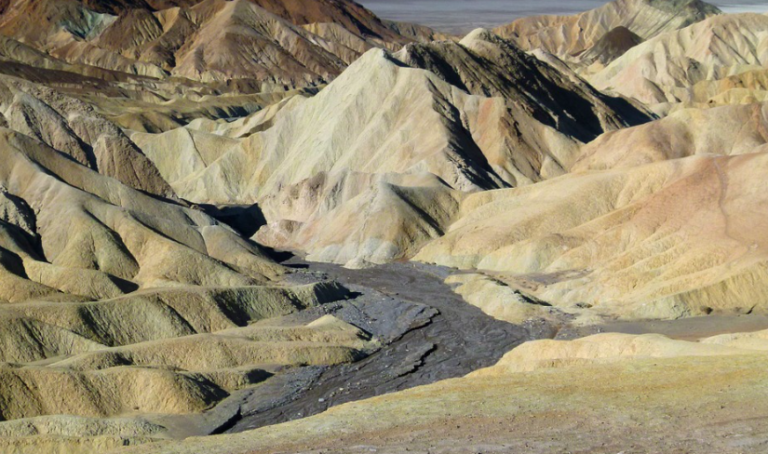はじめに
TED-Ed動画には12のジャンルがあり、今回はその中の”Science and Technology”の動画リストを見ていて、”valley of death”という単語に目についたので、これを選んでみた。ベンチャービジネスが直面する試練の一つだ。興味深いと感じた方はぜひ視聴してみて欲しい。
(出典:YouTube)
死の谷
3月11日に経団連副会長の南場智子(DeNA会長)は、スタートアップ企業の育成目標を発表した。企業価値が10億ドル以上の未上々企業であるユニコーンを、現在の10社から2027年までに100社に増やすという挑戦的な内容だ。同時に、スタートアップ企業を10万社に増やすという目標も提示された。ベンチャー企業の成長段階においては、3つの試練がある。一つは基礎研究から応用研究までの期間のフェーズで魔の川と呼ばれる。実際に応用研究に成功してもそれを製品化するまでの期間のフェーズで死の谷(The valey of death)という。これが今回のテーマ。そして、最後は、製品化に成功してからそれが事業として成功するまでの期間のフェーズでダーウィンの海と呼んでいる。これらを総称してデスバレーと呼ぶこともある。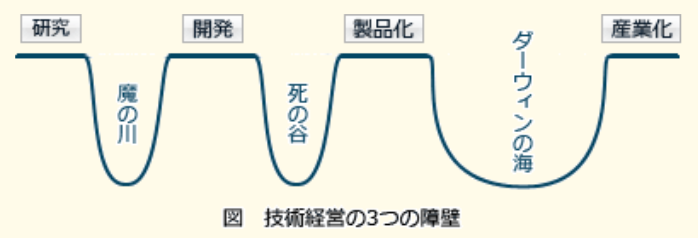
(出典:応用情報処理技術者試験.com)
太陽光パネル
太陽光パネルのコストは2009年以降90%近く下がったと動画にある。資源エネルギー庁によると、下の表に示すように、事業用太陽電池の10kw以上の買取価格は、2012年の40円から2020年には12円まで低下し、2025年の価格目標が7円とされている。太陽光パネルは低廉化が進むが、問題はどこに設置するのかだ。フランスでは家屋の屋根への設置を強化しているようだけど、日本では山林の南面を大規模に削ったり、耕作放棄地を大規模ソーラーに転用しようという動きが目に付くが、これは土砂災害や農地の荒廃などの問題が懸念される。個人的には、メガソーラは発電場所が消費地と遠く送電ロスなどが大きい。地産地消として、消費地で発電するのが効率的だ。具体的には、ペロブスカイト太陽発電(PSC)の紹介でも投稿したように、建物の屋根や壁などが太陽光発電パネルとなる建材一体型太陽光電池(BIPV)に普及に期待を寄せている。ただ、住宅地での反射の問題など解決すべき課題は多いけど、日本がリードする技術の一つでもあり、今後の躍進に期待したい。
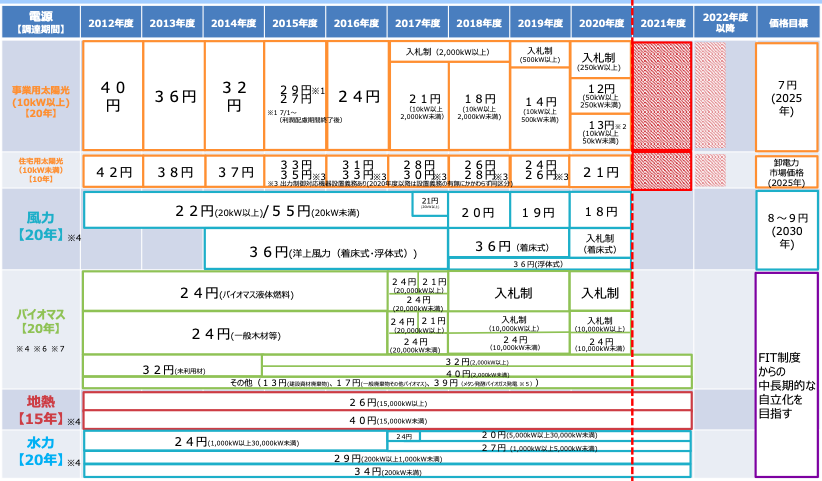
(出典:資源エネルギー庁)
風力発電
動画ではデンマークが1970年代の石油危機の頃から風力発電に投資しているという説明があった。下の図にはデンマークは含まれていないけど、2018年時点でドイツは1kWhあたり8.8円を実現している。日本では同20円と高止まりしている。風力発電の場合には、陸上風力と海上風力が想定されるが、いずれも消費地からは遠いため、水素などに変換するのか、蓄電池に貯めるのか、送電インフラを強化するのかという課題がある。また、狭い国土のどこに設置するのかとか、海上の場合には台風や自然災害時のリスクは回避できるのかという重い課題もある。
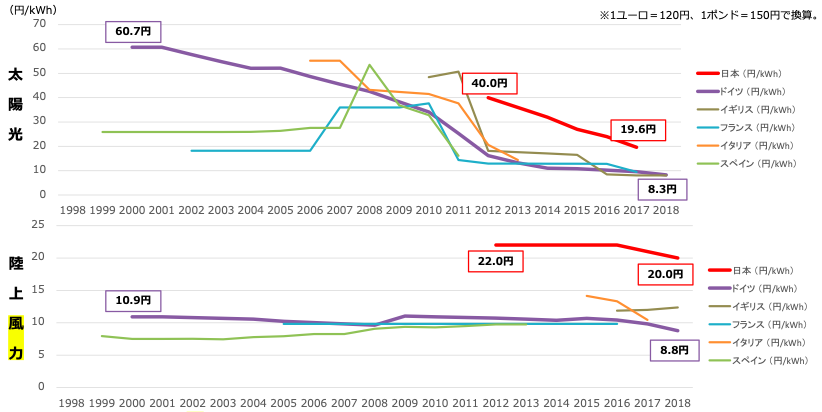
(出典:資源エネルギー庁)
8つの質問
TED-Edで動画を視聴すると、8つの質問がある。
Q1) The valley of death is __________.
死の谷とは何かという説もんだ。新製品が利益を生むようになる前の段階(The phase before new products become profitable)が正解だろう。
Q2) Why don’t zero carbon technologies survive the valley of death?
なぜ、ゼロカーボン技術は死の谷を乗り越えられないのかという設問だ。選択肢には、「開発コストが高く、生産期間が長い。」、「需要が少ない」、「インフラや消費者の行動を大きく変える必要がある」が並ぶがいずれでもないので、「Any of the above」が正解だった。個人的には、パネルのコストは下がっているけど、運用コストは高止まりしているし、インフラの増強は必要だし、消費者行動も変える必要があるので、ちょっと疑問。
Q3) Who can fund the development of new products when private investors don’t?
個人投資家が新製品開発に資金を提供しない場合、誰が資金を提供するかという設問だ。選択肢には、消費者(The consumers)、志を同じくする企業(Like-minded companies)、政府(The government)、上記すべて(All of the above)がある。正解は上記全てとなっているが、日本では消費者によるクラウドファンディングはまだまだ小規模なものが多いし、志を同じく企業による投資はだろう。結局政府による投資に期待が募るが、箱もの投資と非難されがちだ。
Q4) Since 2009, the cost of solar power dropped by almost _________.
動画によると、2009年以降、太陽光発電のコストはほぼ90%低減した。2009年以降の推移ではないが、2012年以降の推移でもかなりドラスティックにコストが低下していることがわかる。

(出典:JETRO)
Q5) Of these countries, which one was the first to invest in wind power?
風力発電に最初に投資した国はどこかという設問だ。動画ではデンマークと説明していた。確かに、デンマークは風力発電を牽引してきた。特に、2000年前後からは米国、ドイツ、スペイン、デンマークの4カ国が市場をリードしてきたが、近年では人口大国である中国やインドが市場を牽引している。日本は2004年時はイギリスに次ぐ世界第8位の風力発電国だったが、新規導入量が停滞した結果、2015年時点では世界第18位にまで後退した。
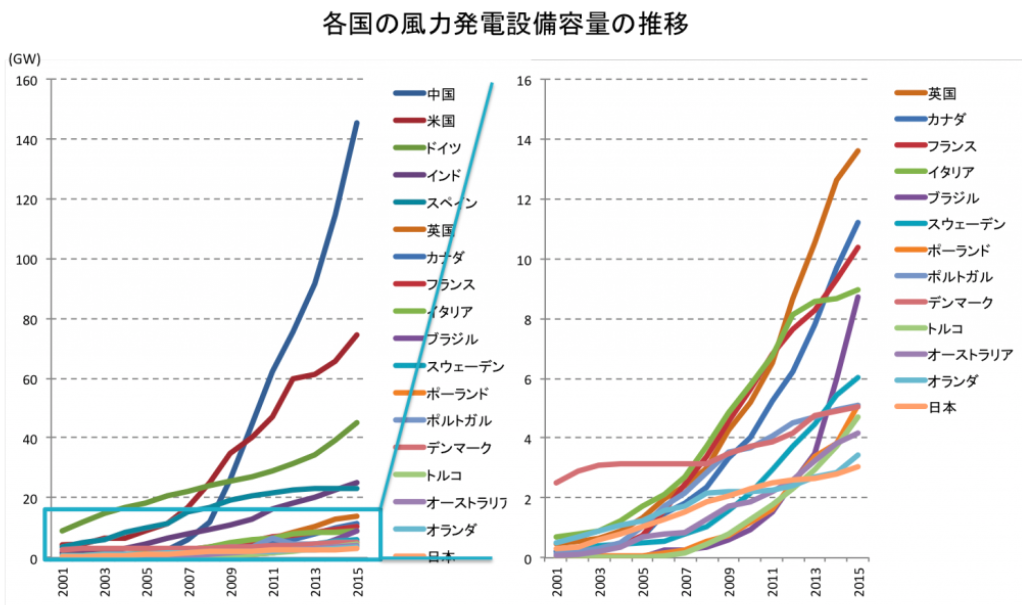
(出典:Sustainable Japan)
Q6) Explain why many new products that are innovative and good for the environment can lose funding while they are in the development phase.
革新的で環境に良い新製品の多くが開発段階で資金を失う理由を問われている。これは前提とする国や地域によって異なる面があるが、一般に、革新的で優れた新製品は、市場、コスト、技術的な問題などの面で困難に直面するので、英語では次のような感じか。
Q7) What happens to the cost of new products, such as zero carbon technologies, when they are adopted worldwide and their demand increases?
ゼロ・カーボン技術などの新製品が世界中で採用され、需要が拡大した場合、そのコストはどうなるかと言う設問だ。新製品の採用が世界中で進めば、コストは下がり、市場規模は大きくなる。新しい技術は、良い意味で需要供給の循環を加速させるので、英語では次のような感じにした。
Q8) Describe two examples that show government initiatives can successfully help zero-carbon technologies survive the valley of death.
政府の取り組みによって、ゼロ・カーボン技術が死の谷を乗り越えられることを示す2つの事例を説明しなさいと言う設問だ。どこまで詳しく書くべきかによるが、シンプルには太陽電池と風力発電なので、次のような感じか。
まとめ
死の谷とあるので、ベンチャービジネスの話かと思ったら、太陽光発電と風力発電の話がメインだった。エネルギー問題は世界の紛争の種でもある。ロシアがウクライナを侵攻していると報道されているが、ロシアが強気な理由の一つは天然ガス資源を握っていることだ。また、空路の実効支配権も大きい。今後温暖化が進めば、北極海ルートの航路の利用の可能性について投稿したが、これもロシアとの友好的な関係が前提だ。個人的には日露間の天然ガスパイプやロシアと日本を結ぶ送電網の可能性に期待しているが、この情勢では実現はさらに先だろう。また、バイカル湖への旅も遠のくことになるのは本当に残念だ。
以上
最後まで読んで頂きありがとうございます。
拝
参考:英文スクリプト
They have passed every test, cleared every hurdle, jumped through every hoop(輪). Now, all that remains is to unleash(解き放つ) them on the world. But wait – that is this? Ah, yes, there is one more challenge. They must now across the valley of death. All new products must pass through here before they reach the market. Many never make it out, and sometimes that is OK – if they don’t work, don’t fill a need, or for any number of other reasons. But inventions that could help address massive global issues also face this risk. That is because a technology’s potential is not the only factor that determines whether it will succeed. The valley of death is especially risky for innovations involving complex physical objects as opposed to software, and for those in highly regulated industries, like medicine, building materials, and transportation.
Regulations and other obstacles are not inherently bad – they are often designed to keep people safe – but they do tend to scare off investors, and that is what traps good ideas in the valley of death: their funding dries up before they can become profitable. One of the fields where this problem is most pressing today is zero-carbon technologies. They are essential to our future, because they will help us eliminate greenhouse gas emissions and stabilize our climate. But they also have features that make them particularly vulnerable(傷つきやすい) in the valley of death. Let us look at why that is, and how we can change it. All new technologies must go through a development phase before they can become profitable. For zero-carbon technologies, the costs of this phase are high, the timelines long, and, in spite of the good they can do, demand is often low because they can require big changes in both infrastructure and consumer behavior. For example, electric heat pumps don’t burn fossil fuels and when you factor in saving on energy use, are cost-competitive with gas furnaces(炉), but homeowners only change their heating and cooling systems every few decades. Direct air capture technologies, meanwhile, remove CO2 directly from the atmosphere. We need these technologies to reach our emissions goals, and several of them have already been proven to work, but they are at risk of getting trapped in the valley of death because they are expensive.
This creates a vicious cycle because the best way to lower costs is by, well, practicing: making more of a product and refining it. But high initial costs scare off investors, and without their money, companies can not continue to develop their technologies – and can not ultimately decrease costs. Fortunately, there is a way to break this cycle: governments can help close the gap, when private investors won’t fund technologies with such a high potential for social benefit. This is not just theoretical: in the 1990s, functioning solar panels existed, but were not widely adopted because of their cost. To change this, Germany offered government loans to companies creating solar panels, and regally obligated utility companies to buy electricity produced using renewable energy. The U.S. and China followed suit by financing major solar panel projects. The cost of solar has dropped almost 90% since 2009, making it much easier to adopt. A similar thing happened for wind energy: during the oil crisis of the 1970s, Denmark invested in wind power and started taxing winds’ fossil fuel-based competitors, other countries took similar steps, and as more wind power was generated worldwide, the cost of this technology dropped dramatically.
These success stories tell us that government initiatives work – initiatives like boosting spending on research and development, offering tax and loan incentives to startups that want to develop zero-carbon technologies and consumers who want to buy them, and putting a price on carbon emissions. We need governments to do what they did for solar and wind for many more innovations. At the end of the day, ideas and inventions alone can not solve our most daunting(ダンピング) problems – policies and markets have to be shaped so the most proising(有望な) technologies can succeed.

